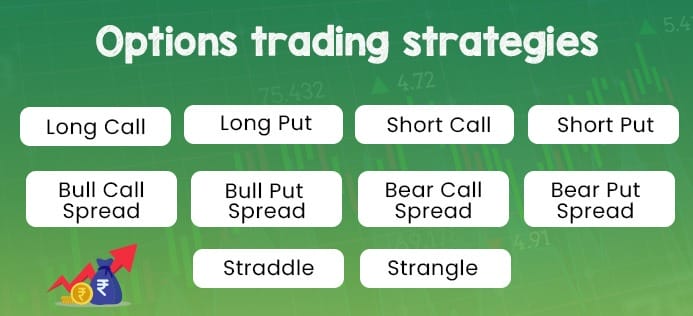
- Stock Market
- September 4, 2023
- 5 Mins Read
Mastering Options Trading: 10 Must-Know Strategies

Options trading is a derived (derivatives trading) method that allows investors to trade a fundamental asset at a decided price and time. It serves various purposes like hedging, assumption, income generation, and portfolio variation. Traders are often involved in options trading without completely understanding the collection of available strategies. Numerous strategies can help mitigate risk and maximise returns. By putting in a little effort, traders can learn how to control stock options' flexibility and potential power. Here are ten must-know strategies for options trading in India.
1. Long Call
A long call is a strategy that reflects a bullish outlook. It involves purchasing a call option on an underlying asset with the expectation that its price will rise. The investor pays a premium for the call option and anticipates that the asset's price will exceed the strike price before the expiration date. This strategy offers unlimited profit potential while limiting the maximum loss to the premium paid.
2. Long Put
A long put is a strategy used by investors who anticipate a decline in the price of an underlying asset. It involves purchasing a put option, for which the investor pays a premium. In this particular strategy, the initial step involves buying a call option and then closing our position at a later time. It is important to note that this approach differs from the "Naked Call" (Short call) strategy. It involves selling calls and repurchasing them at a lower price. The long-call option strategy is most effective when we expect the primary instrument to experience positive movement shortly.

3. Short Call
Selling a call option and collecting a premium is known as a short call strategy. This strategy is employed when an investor anticipates the price of the underlying asset to decrease or remain relatively low. Although this approach offers potential profit up to the amount of the premium collected, it also carries unlimited risk if the asset's price rises significantly. The Short Call strategy is most effective when you expect a moderate decrease in the primary asset (to go or stay below a certain price till expiry of the option). It will also benefit you if the asset remains at its current level since the time decay component will work in your favour.
4. Short Put
A short put strategy involves selling a put option to collect a premium. This strategy is used when the investor expects that the price of the underlying asset will either increase or remain stable. The potential profit is limited to the premium received, while the potential loss is limited to the difference between the strike price and the premium. A short put occurs when a trader sells or writes a put option on a security. This strategy aims to profit by collecting the premium associated with the sale of the put option, anticipating a rise in the stock's price. However, the option writer will face losses if the stock's price decreases.
5. Bull Call Spread
A bull call spread is a strong strategy where a call option with a lower strike price is bought and sold with a higher strike price on the same asset. This strategy reduces upfront costs and limits profit and loss potential. The break-even point is the lower strike price plus the net premium paid.
6. Bull Put Spread
A bull put spread is a bullish strategy where a set option with a higher strike price is sold, and a selected option with a lower strike price is bought. This strategy generates income from net premiums and limits profit and loss potential. The break-even point is the higher strike price minus the net premium received.
7. Bear Call Spread
A bear call spread is a bearish strategy where a call option with a lower strike price is sold, and a higher strike price is bought, generating income from net premiums. The break-even point is the lower strike price plus the net premium received. Investors commonly utilise this bear call strategy when they have a positive outlook on the fundamental asset and predict a moderate increase in its price.
8. Bear Put Spread
A bear put spread is a bearish strategy where a set option with a higher strike price is bought, and a selected option with a lower strike price is sold. It reduces the upfront cost and limits profit and loss potential. The break-even point is the higher strike price minus the net premium paid. It helps limit your potential gains while reducing the amount you spend on premiums. When the cost of purchasing puts individually is high, you can balance it by selling lower strike puts alongside them. It is the central concept behind constructing a bear put spread.
9. Straddle
A straddle is a neutral strategy buying call and put options with the same strike price and expiration date on the same asset. It allows unlimited profit and full loss potential, with break-even points determined by the strike price plus and minus the premium paid. The Straddle strategy is one of the top strategies for Options Trading in the Indian Market. There is no impact on the potential profit or loss. The market can move in any direction, but what remains constant is the strategy's lack of dependency on market direction.
10. Strangle
A strangle is a neutral strategy buying call and put options with different strike prices on the same asset, offering unlimited profit potential and limited loss potential. Break-even points are the higher strike price plus the total premium paid and the lower strike price minus the unlimited premium paid. An investor uses this method with the price of the principal asset, which will experience a substantial variation yet remains unclear about the specific direction in which the change will appear.
Summary
Traders have various strategies available to use. Active and day traders must utilise trading strategies to understand price movements and benefit from trading positions. While some traders approach the market in one way, only a few integrate the hybrid strategies mentioned above. It's important to note that these strategies require careful analysis, planning, and execution to be effective. Additionally, investors should know the risks, costs, and tax implications of options trading. Seeking advice from a financial advisor before making investment decisions is also highly recommended.